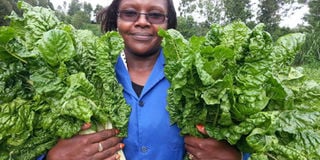Guide to growing spinach

A farmer with bunches of spinach harvested from her farm. File photo.
What you need to know:
- Spinach is a nutritious, hardy cool weather crop, grown for use as a cooked green vegetable or as salads, writes Lominda Afedraru.
- Spinach is a cool weather vegetable and can survive the first frost of temperate climates. It germinates and grows optimally at temperatures between 4-16°C.
Spinach is a nutritious, hardy cool weather crop, grown for use as a cooked green vegetable or as salad. There are two main types of spinach, that is, smooth leaf and savoy (crinkled leaf).
Soil fertility
It is always important to test the soil nutrient level before planting as the pH should be maintained at 6.5 to 6.8. Soils with low pH will result in slow growth and chlorotic leaves.
Because of sensitivity to magnesium deficiency, older spinach leaves may tend to show yellow colour similar to that caused by nitrogen deficiency or downy mildew.
Requirements
Spinach is a cool weather vegetable and can survive the first frost of temperate climates. It germinates and grows optimally at temperatures between 4-16°C. Spinach grows best in loamy soil with an optimum pH of between 6.4 and 7.
It is sensitive to acidic soil and if the pH is too high. Although it prefers full sun, spinach can still produce significantly in partial shade. In hot weather, seeds germinate slowly or may fail to germinate completely.
Planting
Propagation of spinach is solely by seeds. It is first raised in a nursery before transplanting into the main field.
“Prepare the nursery bed, a metre-wide against the required length. Drill seeds across the bed at a depth of about 1cm, cover seeds lightly with soil and the nursery bed with a thin layer of dry grass (mulch). Water the nursery bed and seeds germinate within 5-7 days. Seedlings should be watered regularly,” says Angelo Omach an agronomist at Naro.
Transplanting
“Seedlings should be ready for transplanting after four weeks, when with three to four leaves. This, however, depends on the ecological factors in the region, like temperature,” says Omach. The agronomist says transplanting should be done on a cloudy day or late in the evening when the sun is cool.
Procedure
Select a site with full sun to light shade and well-drained soil. Plough the land two weeks in advance at a depth of at least 20cm and harrow the field. Prepare raised beds, recommended for proper drainage and root establishment depending on the amount of rainfall available.
“However, in dry areas, you can make a flat or sunken bed because of rain limitation,” he says, adding, “The beds should be 15cm high, a metre wide and about 100 metres long. Incorporate soil with manure and DAP. Water the beds, unless the soil is wet enough.”
Weeding
Weeds compete with the crop for growth factors like nutrients as well as they harbour pests. They should, therefore, be controlled. Since spinach roots are shallow and easily damaged, care must be taken when weeding.
Mulching
This helps to keep the soil moist and to suppress weeds. Decomposed mulch releases nutrients into the soil, which are absorbed by the crop. It also helps prevent soil erosion.




